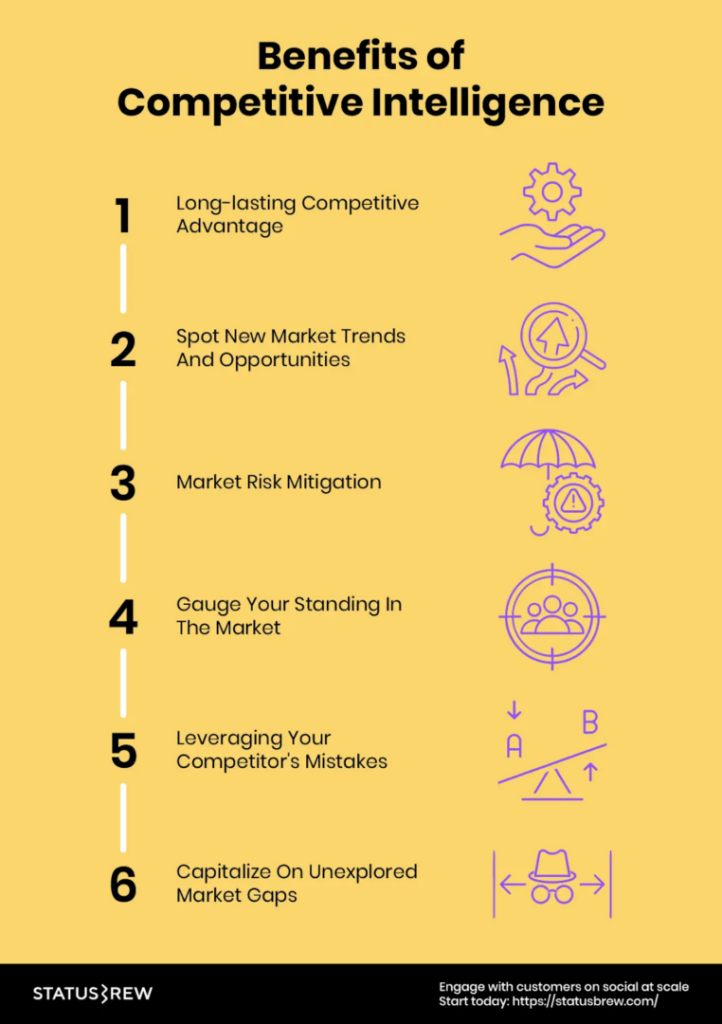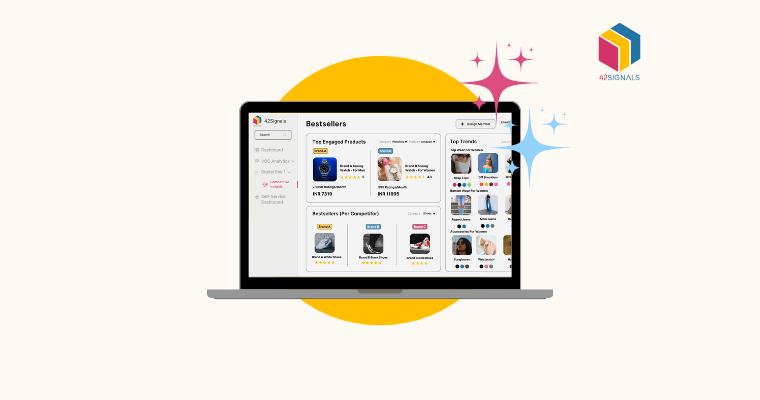Competitive Intelligence (CI) represents a critical component of contemporary corporate strategy, involving the meticulous acquisition, evaluation, and interpretation of information related to competitors, market trends, and industry happenings. Businesses utilize CI tools to glean actionable insights, allowing them to navigate dynamic market environments, anticipate rival maneuvers, and promptly adapt to evolving circumstances.
Typical CI software suites encompass real-time monitoring, advanced data analysis, timely alerts and notifications, comparative benchmarks, collaborative features, visually engaging dashboards, and seamless integrations with other essential business applications.
By incorporating up-to-date and accurate competitor insights, businesses strengthen their positioning within the market and drive overall performance improvements. These tools enable companies to:
- Monitor their competition’s online presence
- Track changes in market share and industry trends
- Competitor analysis of product offerings and pricing strategies
- Gather insights from news, social media, and customer feedback
- Predict competitors’ future strategies and maneuver accordingly

Image Source: Status Brew
By leveraging such software, businesses gain actionable intelligence, which supports strategic decision-making and fortifies their market position.
Key Features of Competitive Intelligence Tools
- Real-Time Monitoring: Continuous tracking of competitors’ online activities, including social media, website updates, and news releases.
- Data Analysis: Sophisticated algorithms that analyze market trends, providing actionable insights.
- Alerts and Notifications: Immediate updates when competitors make significant moves or when relevant market changes occur.
- Benchmarking Capabilities: Tools to measure performance against competitors across various metrics.
- Collaboration Features: Platforms often include functions for teams to share insights and work together.
- Dashboard and Reporting: Customizable interfaces that present data in a clear, digestible format.
- Integration with Other Tools: Ability to mesh with CRM, analytics, and marketing software for streamlined operations.
Competitive Intelligence Tools
For competitive intelligence, robust tools are paramount to gain strategic edges. Here are three competitive intelligence tools:
- 42Signals offers nuanced market insight, tracking competitors’ digital shelves and customer sentiment to inform strategic decision-making.
- Crunchbase Pro provides deep dives into industries, companies, and their financials, fostering a comprehensive understanding of market dynamics.
- SimilarWeb allows users to analyze web traffic and user engagement metrics, shining light on competitors’ online performance and audience behavior.
Leveraging these tools equips businesses with invaluable data to outmaneuver competition effectively.
5 Ways Competitive Intelligence Software Can Help You Outperform Competition

1. Stay Informed with Real-Time Market Insights
Competitive intelligence tools are essential for businesses to monitor the market continuously. They provide:
- Instantaneous updates on market trends
- Insight into competitors’ activities
- Alerts on new entrant strategies
- Analysis of consumer behaviors and preferences
Companies can leverage competitive intelligence tools to base their decision-making process on solid data evidence. Utilizing real-time analytical capabilities enables enterprises to promptly and adeptly navigate market shifts while confidently capitalizing on burgeoning opportunities. Integrating timely competitive intelligence into your strategic planning process can confer marked competitive benefits.
2. Identify Industry Trends and Opportunities
Competitive intelligence tools are indispensable when identifying arising trends and uncovering unexplored market prospects, as they equip businesses with knowledge to capitalize on strategic advantages. By systematically analyzing data from various sources—industry reports, news articles, social media, and competitor behavior—companies can:
- Spot shifts in consumer preferences or emerging demographics
- Detect new technological advancements or disruptions within the industry
- Uncover regulatory changes that may impact market dynamics
- Identify potential partnerships, mergers, or acquisitions to expand their market presence
Drawing upon these insights empowers organizations to make wise, educated decisions, allowing them to effectively adapt their strategies and keep a competitive edge in their industry.
3. Monitor Your Competitors’ Movements
Keeping an eye on competitors is pivotal for maintaining a competitive edge. Competitive intelligence tools facilitate this by tracking competitors’ online activities. Firms can monitor:
- Product launches and feature updates.
- Pricing changes and promotional strategies.
- Partnerships, mergers, and acquisitions.
- Website traffic and SEO strategies.
- Social media presence and engagement levels.
- Customer reviews and feedback.
Equipping themselves with such resources, businesses obtain the means to craft shrewd reactions to market ebbs and flows, spotlight their unique value propositions, and envision forthcoming industry trajectories—ultimately retaining a cutting-edge posture amidst the competition.
4. Optimize Sales and Marketing Strategies
Competitive intelligence tools significantly contribute to honing sales and marketing initiatives. They accomplish this by dissecting competitors’ selling methods and promotional approaches, which then assists companies in detecting tendencies and shortcomings within their own strategies. Key actions include:
- Tracking competitors’ promotional activities to determine successful tactics.
- Monitoring social media for real-time insights into competitors’ customer engagement strategies.
- Assessing competitor pricing strategies to ensure competitive pricing.
- Analyzing market share changes to adjust sales targets and resource allocation.
Through these insights, businesses can tailor their offerings, identify new market opportunities, and outmanoeuvre competitors, leading to improved conversion rates and market positioning.
5. Improve Product Development and Innovation
Essential for thriving in fierce competition, CI tools enhance product development and foster innovation. Armed with real-time insights, businesses can refine current offers, capitalize on emerging trends, and continuously stand apart from competitors. Adopting CI tools guarantees a forward-looking mindset centered around meeting customer demands and achieving lasting market dominance. These tools enable companies to:
- Analyze competitors’ product offerings, revealing gaps in the market.
- Identify emerging trends and technologies that may disrupt current market dynamics.
- Monitor customer feedback across various platforms for insights into desired features and improvements.
Firms using competitive intelligence (CI) tools can enhance their product development approaches by creating solutions tailored to customer demands yet still maintaining a lead over competitors. Equipped with practical insights, businesses can drive purposeful innovation, preventing merely reactionary measures and preserving their strong foothold in the market. Applying CI tools empowers companies to identify emerging trends early and adjust accordingly, thereby strengthening their overall competitive stance.
Conclusion
Essential in today’s shifting business terrain, competitive intelligence tools equip companies striving for leadership positions with actionable insights regarding markets, consumers, and competitors. Applying these instruments intelligently results in well-informed choices sparks inventiveness, and cultivates forward-thinking mindsets.
Firms embracing competitive intelligence stand to minimize risk exposure, exploit openings, and solidify a dominant position in their sectors – all thanks to enhanced preparedness and foresight derived from savvy tool usage.




